
The superfamily Apoidea is a major group within the Hymenoptera, which includes two traditionally recognized lineages, the "sphecoid" wasps, and the bees. Molecular phylogeny demonstrates that the bees arose from within the traditional "Crabronidae", so that grouping is paraphyletic, and this has led to a reclassification to produce monophyletic families.
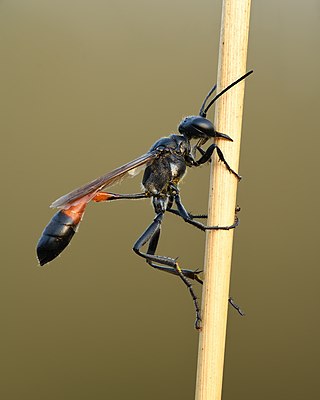
The Sphecidae are a cosmopolitan family of wasps of the suborder Apocrita that includes sand wasps, mud daubers, and other thread-waisted wasps.
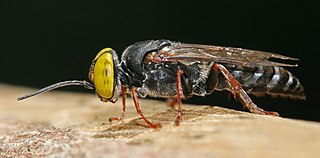
The Crabronidae are a large paraphyletic group of wasps, including nearly all of the species formerly comprising the now-defunct superfamily Sphecoidea. It collectively includes well over 200 genera, containing well over 9000 species. Crabronids were originally a part of the Sphecidae, but the latter name is now restricted to a separate family based on what was once the subfamily Sphecinae. Several of the subfamilies of the Crabronidae are often treated as families in their own right, as is true of the most recent phylogenies.

The Spheciformes is a paraphyletic assemblage of insect families which collectively comprise the "sphecoid wasps". Larvae are carnivorous.
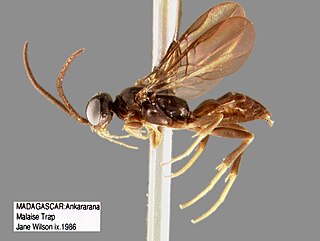
Heterogynaidae is a minor and disputed lineage of small spheciform wasps occurring in Madagascar, Botswana, Turkmenistan, Oman, the United Arab Emirates, and the Eastern Mediterranean area. The majority are dark in color and range in size from approximately 1.5 to 5.0 mm. Most specimens have been collected in arid climates, but one species from Madagascar is known to occur in a humid forest habitat. Although males have functional wings, heterogynaid females are typically brachypterous, a trait which is unique among spheciform wasps. Wing venation is reduced in both sexes. All species are diurnal, with the exception of H. nocticola. Other aspects of their biology are completely unknown, but details of their morphology have prompted researchers to hypothesize that they may be non-fossorial parasitoids adapted to hunt in tight spaces, such as under tree bark. This is speculative and has not yet been confirmed by actual observations of behavior. It is also possible that modifications of the female metasomal tergum VI and gonostyli may represent a unique prey transport mechanism, but this is also unconfirmed.
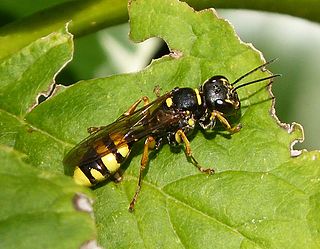
Mellinidae is a small family of wasps, comprising 17 described species in two genera. This group has traditionally been treated as a subfamily within Crabronidae (Mellininae), but recent phylogenomic studies have shown it to be a distinct family.
Bothynostethini is a small neotropical tribe of solitary wasps partly recognizable for having peculiar modifications at the apex of the hind femora.

The subfamily Pemphredoninae also known as the aphid wasps, is a large group in the wasp family Crabronidae, with over 1000 species. Historically, this subfamily has frequently been accorded family status. In some recent phylogenetic analyses, one of the subtribes within this group is the sister lineage to the superfamily Apoidea, and accorded family rank as Ammoplanidae along with Pemphredonidae and Psenidae so as to keep families monophyletic.

Ammophilinae is a subfamily of thread-waisted wasps in the family Sphecidae. There are about 6 genera and more than 320 described species in Ammophilinae.

Psenini is a tribe of aphid wasps in the family Crabronidae. There are about 11 genera and at least 460 described species in Psenini.
Aphilanthops is a genus of ant queen-kidnapping wasps in the family Crabronidae. At least four species in Aphilanthops are described.
Didineis is a genus of wasps in the family Crabronidae. There are more than 20 described species in Didineis.
Anacrabro is a genus of square-headed wasps in the family Crabronidae. There are about 15 described species in Anacrabro.
Pulverro is a genus of aphid wasps in the family Crabronidae. There are about 13 described species in Pulverro.

Ammoplanops is a genus of aphid wasps in the family Crabronidae. There are about 15 species described in the genus Ammoplanops.

Lestiphorus is a genus of sand wasps in the family Crabronidae. There are about 18 described species in Lestiphorus.
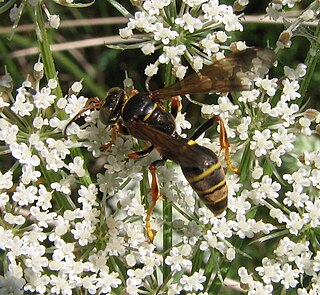
Saygorytes is a genus of sand wasps in the family Crabronidae. There are about seven described species in Saygorytes.

Psammaletes is a genus of sand wasps in the family Crabronidae. There are about nine described species in Psammaletes.
Miscophus is a genus of square-headed wasps in the family Crabronidae. There are more than 180 described species in Miscophus.

Ammoplanidae is a family of aphid wasps formerly treated as the Crabronidae subtribe Ammoplanina. There are about 10 genera and at least 130 described species in Ammoplanina. Phylogenetic analyses in 2018 and 2021 have confirmed this group as the sister lineage to the bees, and thus accorded the group family rank.















